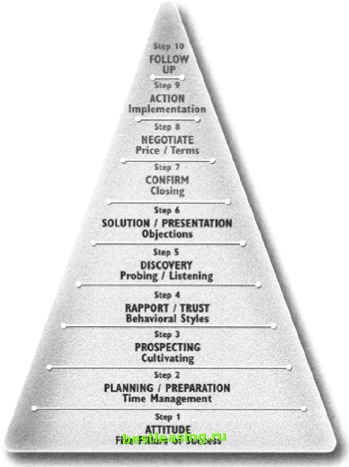

 |
 |

|
Промышленный лизинг
Методички
Bring It Forward Another common situation involves the stall objection or the timing objection. A customer may say: Sounds good but we cant look at it until the next quarter or our next fiscal year. Call me in six months. The timing may not be good or they need to stall until a new budget becomes available. My strategy in these situations is to bring it forward-bring the situation forward as if the customer were making a decision today. Simply invite the customer to enter into the hypothetical arena and ask, Hypothetically, if you were to consider making a decision today, what would you be looking for? Whats important to you? Maximize this opportunity with the customer, do a mini-discovery to learn some initial criteria for when it comes time to make a decision. You then provide a mini-presentation, giving your customer some insight into what your solution can offer. If your customer is receptive and sees value, ask him or her a hypothetical close, If you were to make a decision today, would you buy from me? Remember, reiterate to the customer that this is all hypothetical so by no means are they making a commitment. By going through this bring it forward strategy, you and your customer know there is valid reason to take a serious look at you come decision time. This strategy far outweighs the alternative, which is to say to your customer: Okay fine, I understand you wont be looking at this for six months. Ill call you then. Dont leave yourself vulnerable to the competition. Secure an initial commitment by using the bring it forward strategy and you may pique the customers interest enough that he looks forward to having a serious conversation with you at the appropriate time. Heck, he may even say to your competitors, Thanks for calling but were already looking at somebody. Your overall objective is to deliver a creative, value-added solution that leaves no doubt in the customers mind that youre the best solution. Make a vivid impression with an innovative, convincing presentation. Cookie-cutter, boring presentations do little to advance the sale-customers buy differences, not similarities. Dont overlook the you solution. Your competitor may offer similar products or services with competitive pricing, but they cant duplicate you. Next time youre asked the question, Why should I buy from you? look the customer square in the eyes and say, Because Im your salesperson. Dont depend on a product solution or a price solution to differentiate yourself. Your greatest asset is yourself. 1кШи1И=1 И1лллнн1Ы1 дзд  Notes 1. Wilson, Larry. Changing the Game: The New Way to Sell. Page 81, 1987. Simon & Schuster Inc.. 2. Decker, Bert. Youve Got to Be Believed to Be Heard: Reach The First Brain to Communicate in Business and In Life. Page 84, 1992. St. Martins Press. 3. Brooks, William T. Niche Selling: How to Find Your Customer in a Crowded Market.. Page 28, 1992. Business One Irwin.  Congratulations, you have now completed Step #6  ИШЛ1Л Chapter 9: Confirming the Sale: Closing Overview People buy from people. Better yet, people love to buy. The buying experience can be very rewarding and can satisfy many of the motives to buy: ego, prestige, status, greed, joy of spending money, peace of mind, and so on. The ideal sales process is a mutual journey of honesty, trust, and respect as you and your customer work in harmony through the Sequential Model. When the journey is mutual, confirming the sale is not a matter of if, but when. Traditionally, this step is referred to as closing the sale. However, the word closing has negative connotations that conjure up images of unscrupulous sales representatives using manipulative, guerrilla tactics designed to coerce unsuspecting customers into buying. Traditional closing techniques typically violate the sales relationship. Customers today are tired and irritated by these offensive, manipulative, unethical arm-twisting tactics. Make buying easy for your customer by confirming the sale using a nonmanipulative, straightforward approach and presenting a practical, value-added solution. Confirming is the pinnacle of selling achievement. It is when the customer awards a gold medal to the salesperson who delivered a win-win, value-added performance. However, confirming does not happen in isolation from the total sales process. You need to be engineering commitment throughout the entire sales call because anything you do or say, at any step, will either erode or enhance the sale. Chronologically, the confirmation comes as Step #7 of the Sequential Model, but be cognizant that your success at this point is based on a series of buy-ins or confirmations throughout the journey. Confirmation simply means to create a shared sense of enthusiasm to do business then exercise the power of asking. The ideal situation is a sales entrepreneur who can confidently ask for the business and at the same time be diligent in building a relationship by asking smart questions. Dont underestimate the power of asking. Man who wait for roast duck to fly into mouth, wait very, very long time. Chinese Proverb Why is it that so many salespeople become paralyzed with fear at the thought of closing? Even when they have successfully navigated through the previous six steps they still fail to ask for a buying decision. The reasons are as diverse as customers themselves. The most common one is fear. Fear of rejection, fear of sounding silly, fear of failure, fear of upsetting the customer, the feeling of not being good enough or worthy enough to ask. All valid reasons, but unfortunately this becomes a negative habit pattern that seriously compromises our success at confirming. In the interest of harmony and not offending a potential customer, we unknowingly sacrifice our own agendas by failing to ask. Psychologists agree that the fear of asking is learned through negative conditioning experienced as early as childhood. Our parents, teachers, siblings, and even friends have all contributed to nurturing this debilitating virus. No one is born with it. Your fears are all learned and reinforced through repetition by those around you, even yourself. As one lady said when finally asked out by a fellow she admired, The trouble with you men is that you often reject yourselves before you give us women a chance to. She was elated when he finally asked her out, and without hesitation accepted his invitation. The same analogy applies to salespeople. We often reject or doubt our own proposals or presentations long before we give the customer a chance to. However, because it is a learned condition, it can be unlearned as well, and sometimes very quickly. I suggest there is a direct relationship between low corporate self-esteem and negative self-talk, and your confidence to ask for business. Confirming demands an attitude of confidence, expecting the customer to say yes. Anything less puts you in entrepreneurial quicksand. Just as the Chinese proverb suggests, dont expect rewards such as roast duck or a confirmed sale unless you ASK. 1 2 3 4 5 6 7 8 9 10 11 12 13 14 15 16 17 18 19 20 21 22 23 24 25 26 27 28 29 30 31 32 33 34 35 36 37 38 39 40 41 42 43 44 45 [ 46 ] 47 48 49 50 51 52 53 54 55 56 57 58 59 60 61 62 63 64 65 66 67 68 69 70 71 |